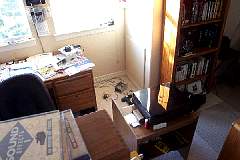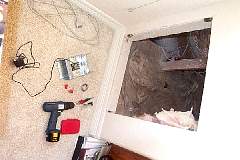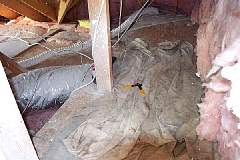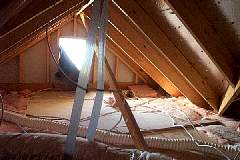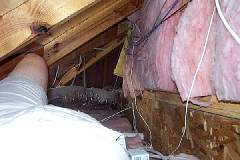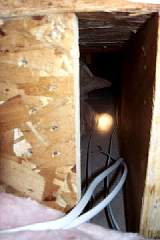An Attic Adventure
Click the Pix to Enlarge (browser back btn to return)
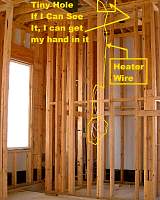 With
the brute force part of the adventure completed, I moved to the delicate finesse
portion of the exercise. Having
been in tight places before, I knew there were advantages to NOT becoming stuck.
Applying a liberal coat of Vaseline all over my body prevented anything
from being left behind, as well as deterring fiberglass.
Gee - - I don’t think so. Maybe
I just took a shower afterwards. At
any rate, finding the spot where the wire went through the wall plate involved
stripping out all of the walls in the bathroom (see photo) so that the wire’s
path could be accurately identified (see yellow line).
OK, OK - - I fibbed - - we took these shots while the house was being
built. Came in handy! I was initially concerned about the fiber panel that ran
along the top of the interspace - - but it looked like there was a 6” gap
right where the wire went through (I’m sure we planned it that way), and that
was all I needed.
With
the brute force part of the adventure completed, I moved to the delicate finesse
portion of the exercise. Having
been in tight places before, I knew there were advantages to NOT becoming stuck.
Applying a liberal coat of Vaseline all over my body prevented anything
from being left behind, as well as deterring fiberglass.
Gee - - I don’t think so. Maybe
I just took a shower afterwards. At
any rate, finding the spot where the wire went through the wall plate involved
stripping out all of the walls in the bathroom (see photo) so that the wire’s
path could be accurately identified (see yellow line).
OK, OK - - I fibbed - - we took these shots while the house was being
built. Came in handy! I was initially concerned about the fiber panel that ran
along the top of the interspace - - but it looked like there was a 6” gap
right where the wire went through (I’m sure we planned it that way), and that
was all I needed.

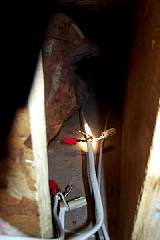 After
turning off all power in the bathroom (I hate surprises), I wiggled my way into
the crawlspace. Finding the tiny gap was straight forward (although it was
hidden behind a wad of insulation), but splicing the Romex was not.
I figured that if I simply cut the wire, it would coil back up with a
happy Sproingggg, dragging itself well back out of reach under the ceiling.
So I stripped the Romex cover off, then cut only one of the 3 wires, and
spliced that to my romex extension line first.
Oh, by the way - - have you ever tried to twist 14 gauge solid copper
wire with your fingers?? DON’T
try this at home!! Fortunately I
had a pair of small vice-grip pliers which did the trick.
With the wires securely captured, I then cut and spliced the remaining
wires. Then - - just because - - I
soldered all connections and insulated them with wire nuts.
The soldering part was pretty interesting because my 25 watt electronics
soldering iron wouldn’t put enough heat into the romex to melt the solder,
even if I could have used an electric iron, which I couldn’t because the power
was off.
After
turning off all power in the bathroom (I hate surprises), I wiggled my way into
the crawlspace. Finding the tiny gap was straight forward (although it was
hidden behind a wad of insulation), but splicing the Romex was not.
I figured that if I simply cut the wire, it would coil back up with a
happy Sproingggg, dragging itself well back out of reach under the ceiling.
So I stripped the Romex cover off, then cut only one of the 3 wires, and
spliced that to my romex extension line first.
Oh, by the way - - have you ever tried to twist 14 gauge solid copper
wire with your fingers?? DON’T
try this at home!! Fortunately I
had a pair of small vice-grip pliers which did the trick.
With the wires securely captured, I then cut and spliced the remaining
wires. Then - - just because - - I
soldered all connections and insulated them with wire nuts.
The soldering part was pretty interesting because my 25 watt electronics
soldering iron wouldn’t put enough heat into the romex to melt the solder,
even if I could have used an electric iron, which I couldn’t because the power
was off.
 Segue
to Radio Shack - - “Hey - - don’t you guys have a little gas powered
soldering iron??” “Yep - -
right over here. Oh, by the way - -
it has a neat little blowtorch attachment - -”
Segue
to Radio Shack - - “Hey - - don’t you guys have a little gas powered
soldering iron??” “Yep - -
right over here. Oh, by the way - -
it has a neat little blowtorch attachment - -”
 Previous
Page
Previous
Page  Rogues
Menu
Rogues
Menu  Next
Page
Next
Page
 With
the brute force part of the adventure completed, I moved to the delicate finesse
portion of the exercise. Having
been in tight places before, I knew there were advantages to NOT becoming stuck.
Applying a liberal coat of Vaseline all over my body prevented anything
from being left behind, as well as deterring fiberglass.
Gee - - I don’t think so. Maybe
I just took a shower afterwards. At
any rate, finding the spot where the wire went through the wall plate involved
stripping out all of the walls in the bathroom (see photo) so that the wire’s
path could be accurately identified (see yellow line).
OK, OK - - I fibbed - - we took these shots while the house was being
built. Came in handy! I was initially concerned about the fiber panel that ran
along the top of the interspace - - but it looked like there was a 6” gap
right where the wire went through (I’m sure we planned it that way), and that
was all I needed.
With
the brute force part of the adventure completed, I moved to the delicate finesse
portion of the exercise. Having
been in tight places before, I knew there were advantages to NOT becoming stuck.
Applying a liberal coat of Vaseline all over my body prevented anything
from being left behind, as well as deterring fiberglass.
Gee - - I don’t think so. Maybe
I just took a shower afterwards. At
any rate, finding the spot where the wire went through the wall plate involved
stripping out all of the walls in the bathroom (see photo) so that the wire’s
path could be accurately identified (see yellow line).
OK, OK - - I fibbed - - we took these shots while the house was being
built. Came in handy! I was initially concerned about the fiber panel that ran
along the top of the interspace - - but it looked like there was a 6” gap
right where the wire went through (I’m sure we planned it that way), and that
was all I needed. 